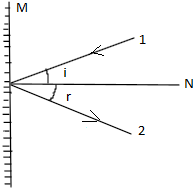
If the incident ray falls on a surface normally, then the angle of reflection is _________ degree.
(A) 90
(B) 0
(C) 30
(D) 60
Answer
220.2k+ views
Hint: The angle of incidence and the angle of reflection are both calculated with respect to the normal drawn to that surface and not with respect to the plane of the surface itself. Also, the angle of incidence is equal to the angle of reflection irrespective of the shape of the reflecting surface.
Complete Step by step solution:
By the law of reflection, it is said that the angle of incidence and the angle of reflection for any ray of light, reflecting off of a surface will always be equal, irrespective of the surface being plane as in the case of plane mirror or curved as in the case of concave and convex mirrors or even in the case of arbitrarily shaped reflecting surfaces. As such the formula is given which is $\angle i = \angle r$where ‘i’ is the angle of incidence or the angle at which the light ray strikes the surface and ‘ r’ is the angle of reflection or the angle at which the reflected ray leaves the surface.
One thing which should be kept in mind is that these angles of incidence and reflection are always measured from the normal to the surface.

The diagram shown above is an instance of reflection. Here ‘N’ is the normal to the reflecting surface ‘M’. ‘1’ shown here is the ray of incidence which forms $\angle i$ with ‘N’ and ‘2’ is the reflected ray which leaves at $\angle r$ with ‘N’. Here $\angle i$ and $\angle r$ will both be equal due to the law of reflection.
As for the question above, the incident ray falls on the surface normally which means that ray ‘1’ will coincide with ‘N’ and as such, will make an angle of ${0^ \circ }$with the same. Thus, by the law of reflection, the reflecting ray that is ray ‘2’ will also make the same angle with the normal which is ${0^ \circ }$ and that ray too will coincide with the normal.
Note:
In case of the curved surfaces such as concave and convex reflecting surfaces or in case of arbitrarily shaped reflecting surfaces, first thing that needs to be done is to plot the tangent at the point of reflection and then perpendicular to the tangent, a normal must be drawn before plotting incidence and reflection rays and angles.
Complete Step by step solution:
By the law of reflection, it is said that the angle of incidence and the angle of reflection for any ray of light, reflecting off of a surface will always be equal, irrespective of the surface being plane as in the case of plane mirror or curved as in the case of concave and convex mirrors or even in the case of arbitrarily shaped reflecting surfaces. As such the formula is given which is $\angle i = \angle r$where ‘i’ is the angle of incidence or the angle at which the light ray strikes the surface and ‘ r’ is the angle of reflection or the angle at which the reflected ray leaves the surface.
One thing which should be kept in mind is that these angles of incidence and reflection are always measured from the normal to the surface.

The diagram shown above is an instance of reflection. Here ‘N’ is the normal to the reflecting surface ‘M’. ‘1’ shown here is the ray of incidence which forms $\angle i$ with ‘N’ and ‘2’ is the reflected ray which leaves at $\angle r$ with ‘N’. Here $\angle i$ and $\angle r$ will both be equal due to the law of reflection.
As for the question above, the incident ray falls on the surface normally which means that ray ‘1’ will coincide with ‘N’ and as such, will make an angle of ${0^ \circ }$with the same. Thus, by the law of reflection, the reflecting ray that is ray ‘2’ will also make the same angle with the normal which is ${0^ \circ }$ and that ray too will coincide with the normal.
Note:
In case of the curved surfaces such as concave and convex reflecting surfaces or in case of arbitrarily shaped reflecting surfaces, first thing that needs to be done is to plot the tangent at the point of reflection and then perpendicular to the tangent, a normal must be drawn before plotting incidence and reflection rays and angles.
Recently Updated Pages
Mass vs Weight: Key Differences Explained for Students

Young’s Double Slit Experiment Derivation Explained

Electricity and Magnetism Explained: Key Concepts & Applications

JEE Energetics Important Concepts and Tips for Exam Preparation

JEE Isolation, Preparation and Properties of Non-metals Important Concepts and Tips for Exam Preparation

JEE Main 2021 July 25 Shift 1 Question Paper with Answer Key

Trending doubts
JEE Main 2026: Application Form Open, Exam Dates, Syllabus, Eligibility & Question Papers

Understanding Uniform Acceleration in Physics

Derivation of Equation of Trajectory Explained for Students

Hybridisation in Chemistry – Concept, Types & Applications

Understanding the Angle of Deviation in a Prism

How to Convert a Galvanometer into an Ammeter or Voltmeter

Other Pages
JEE Advanced Marks vs Ranks 2025: Understanding Category-wise Qualifying Marks and Previous Year Cut-offs

Dual Nature of Radiation and Matter Class 12 Physics Chapter 11 CBSE Notes - 2025-26

Understanding Centrifugal Force in Physics

JEE Main Marking Scheme 2026- Paper-Wise Marks Distribution and Negative Marking Details

Degree of Dissociation: Meaning, Formula, Calculation & Uses

Ideal and Non-Ideal Solutions Explained for Class 12 Chemistry




